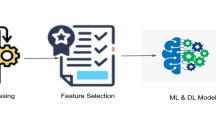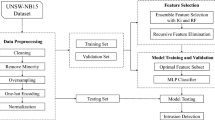Abstract
It is hard to block e-mail bombs because they are usually sent by normal SMTP (Simple Mail Transfer Protocol) applications with fake mail sender addresses and IP addresses. Fortunately, original network packets contain real IP address information anyway. Collecting and analyzing these packet contents can help an administrator to realize where the e-mail bombs are coming from and block them. This article presents a simple method that uses a bandwidth manager device to collect and analyze packets to get e-mail bombs information as well as to block e-mail bomb source IP addresses in routers. In practical application experiences at the computer center in a university, this method blocked e-mail bombs simply and effectively. Furthermore, a fuzzy inference system was also designed to help identify e-mail bombs. Its fuzzy membership functions could be adapted using the fuzzy neural network learning method. In brief, the proposed method affords an automatic and adaptable alarm to find e-mail bombs.
Similar content being viewed by others
References
Barber R (2001) Hackers profiled – who are they and what are their motivations. Comput Fraud Security (2):14–17
Bass T, Watt G (1997) A simple framework for filtering queued smtp mail (cyberwar countermeasures). IEEE MILCOM 97 Proc 3:1140–1144
Bass T, Freyre A, Gruber D, Watt G (1998) E-mail bombs and countermeasures: cyber attacks on availability and brand integrity. IEEE Network 12(2):10–17
Chang FM (2005) An intelligent method for knowledge derived from limited data. In: Proceedings – 2005 IEEE international conference on systems, man, and cybernetics. pp 566–571
Computer fraud & security (1996) E-mail bomb suspect arrested. Comput Fraud Security (2):3
Icove D, Seger K, VonStorch W (1998) Computer Crime. O'Reilly
Jang, JSR (1993) ANFIS: adaptive-network-based fuzzy inference systems. IEEE Trans Syst Man Cybem 23(3):665–685
Jang JSR (1997) Fuzzy inference systems. Neuro-Fuzzy and Soft Computing, Prentice Hall, pp 75–77
Jared S (1998) AOL users fall prey to hackers' dirty tricks. Comput Security 17(2):153
Jha S, Hassan M (2002) Building agents for rule-based intrusion detection system. Comput Commun 25:1366–1373
Kadoya Y, Fuketa M, Atlam E, Morita K, Kashiji S, Aoe J (2004) An efficient e-mail filtering using time priority measurement. Inf Sci 166(1–4):213–229
Kuo YH, Hsu JP, Wang CW (1998) A parallel fuzzy inference model with distributed prediction scheme for reinforcement learning. IEEE Syst Man Cybern 28(2):160–172
Lee CS, Guo SM, Hsu CY (2005) Genetic-based fuzzy image filter and its application to image processing. IEEE Trans Syst Man Cybern Part B 35(4):694–711
Lee CS, Jiang CC, Hsieh TC (2005) A genetic fuzzy agent using ontology model for meeting scheduling system. Inf Sci 176:1131–1155
Lee CS, Pan CY (2004) An intelligent fuzzy agent for meeting scheduling decision support system. Fuzzy Set Syst 142(3):467–488
Leinwand A, Conroy KF (1994) Network management: a practical perspective. Addison-Weslay Longman
Li DC, Wu CS, Chang FM (2006) Using data continualization and expansion to improve small data set learning accuracy for early FMS scheduling. Int J Prod Res 44(21):4491–4509
Lin CT, Lee CSG (1991) Neural-network-based fuzzy logic control and decision system. IEEE Comput 40(12):1320–1336
Oad T, White T (2003) Increasing the accuracy of a spam-detecting artificial immune system. 2003 Congr Evol Comput, pp. 390–396
Rogers MK (2006) A two-dimensional circumplex approach to the development of a hacker taxonomy. Digital Invest 3:97–102
Stevens WR (1994) TCP/IP illustrated volume I: the protocols. Addison-Weslay Longman
Sumitomo T, Kadoya Y, Fuketa M, Morita K, Kashiji S, Aoe J (2004) An new e-mail filtering technique using time priority measurement. In: Proceedings-Ninth internation symposium on computers and communications, pp. 122–127
Wang JH, Deng PH, Fan YS, Jaw LJ, Liu, YC (2003) Virus detection using data mining techinques. In: Proceedings-IEEE 37th Annual 2003 internation carnahan conference on security technology, pp. 71–76
Wood P (2006) The hacker's top five routes into the network (and how to block them). Network Security (2):5–9
Yen J, Langari R (1999) Fuzzy logic—intelligence, control, and information. Prentice Hall
Zakariah R, Ehsan S (2006) Detecting junk mails by implementing statistical theory. In: Proceedings 20th internation conference on advanced inforamation networking and applications
Author information
Authors and Affiliations
Corresponding author
Rights and permissions
About this article
Cite this article
Chang, F.M. An intelligent method to block e-mail bombs. Appl Intell 27, 39–47 (2007). https://doi.org/10.1007/s10489-006-0029-8
Received:
Accepted:
Published:
Issue Date:
DOI: https://doi.org/10.1007/s10489-006-0029-8




